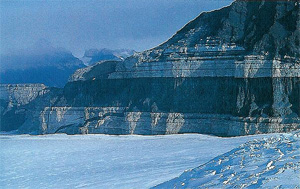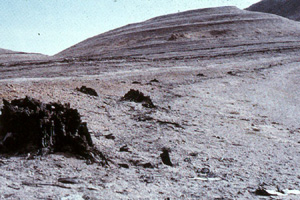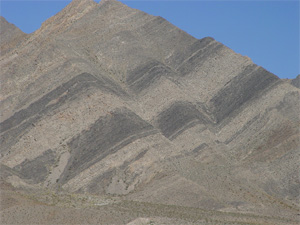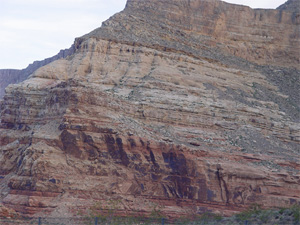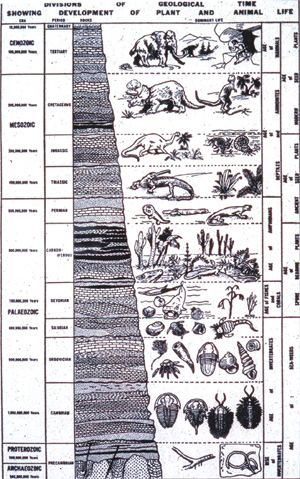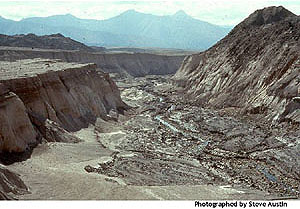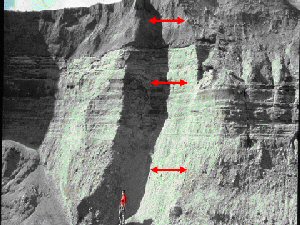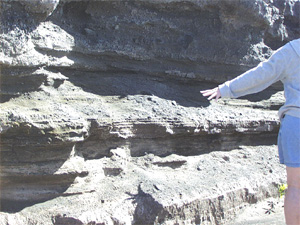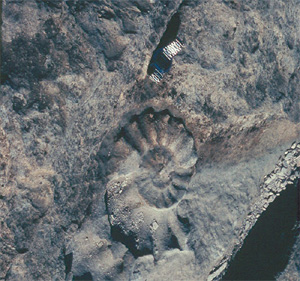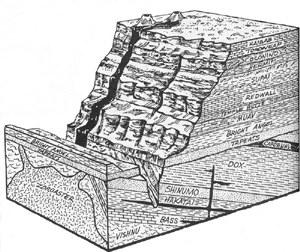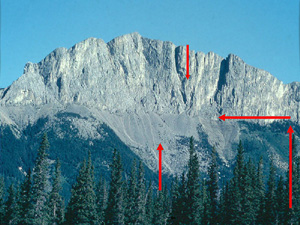We are going to continue with part five of our series called, "Searching for the Truth on Origins." And now we are going to move into a whole new dimension of the creation-evolution debate in that we are going to look at the history of life based on geology. So far we have looked at the universe, our Planet Earth. We have looked at the origin of life through studying biology. Now we want to examine the history of the earth from two views: the evolutionary assumption and the creation view, based on the Scriptures.
I want to begin by reading to you a portion of Scripture from 2 Peter 3:1-4. Peter writes:
This second epistle, beloved, I now write unto you; in [both] which I stir up your pure minds by way of remembrance: That ye may be mindful of the words which were spoken before by the holy prophets, and of the commandment of us the apostles of the Lord and Saviour: Knowing this first, that there shall come in the last days scoffers, walking after their own lusts, And saying, Where is the promise of his coming? for since the fathers fell asleep, all things continue as [they were] from the beginning of the creation.
Now verses 5 to 8:
For this they willingly are ignorant of, that by the word of God the heavens were of old, and the earth standing out of the water and in the water: Whereby the world that then was, being overflowed with water, perished: But the heavens and the earth, which are now, by the same word are kept in store, reserved unto fire against the day of judgment and perdition of ungodly men. But, beloved, be not ignorant of this one thing, that one day [is] with the Lord as a thousand years, and a thousand years as one day.
Now verses 9 and 10:
The Lord is not slack concerning his promise, as some men count slackness; but is longsuffering to us-ward, not willing that any should perish, but that all should come to repentance. But the day of the Lord will come as a thief in the night; in the which the heavens shall pass away with a great noise, and the elements shall melt with fervent heat, the earth also and the works that are therein shall be burned up.
This is a very interesting portion of Scripture. I wanted to read it at the beginning of this presentation because it is dealing with the history of our planet and geology. Peter's message, I sense from reading it, had an urgency and a passion. Peter wants the readers to recall the words of the holy prophets and the words of Jesus. And note this: in the last days, a belief in a literal second coming of Jesus will be replaced by a message of uniformitarianism. What does that mean? Well, Peter said there are going to be scoffers that will come and say, “Where is the promise of His coming?” Regarding the second coming of Jesus, they will say, “Oh they have been saying that for years and He has not come. All things are the same as from the beginning.” That is what I mean by uniformitarianism. That is a big word, so let me define it. It is a term based on geology which implies that the present is the key to the past and that there have been merely gradual changes that have occurred through long periods of time. We will explain this further. They will say, “Don't get upset. Don't get concerned. All things are the same. And this idea that Jesus will return, ha!—forget it!”
Peter continues and he makes this point very clear; he said, “I want you to know that God has judged this planet in the past by a flood. It has been destroyed. It has been covered by water.” But he said, “There's a judgment that's coming in the future and this time it will be by fire. And that judgment will be for the ungodly.” Peter also says that God's time table is not man's time table. And then this important fact: God is not willing that any should perish. God has provided a way of salvation.
You see, one of the reasons why I feel compelled to give these kinds of presentations is to help people to understand that the Bible is true and that what God has said in His Word about what has occurred in the past can be trusted and believed. And if you can trust and believe what God has said about what has happened in the past, then you better pay attention to what He is saying about what is going to take place in the future. And if there has been a judgment that has occurred in the past, there should currently be evidence that it has occurred.
In this presentation, we are going to examine the claims of those who support evolution in the field of geology and see if their claims are true. And then in another presentation following this one, we are going to examine the claims of the Scriptures regarding the origin and the history of our planet. And again we will test the claims based on the same facts, that is, the fossils and the geological layers.
The history of life can be interpreted two ways: first, by man's speculation and secondly, by God's revelation. Why do I say man's speculation? Well you see, when it comes to trying to understand what has occurred in the past, we can not interview anyone who gives testimony of what they saw. We can look at the layers of the earth. We can look at the fossils. What we are going to discover is that man has an agenda to try to interpret the earth's history differently than what we find recorded in the Scriptures, which the Bible says are given to us by inspiration of the Creator. So, we are going to see two widely contrasting views regarding the history of our planet.
The Bible warns us that we need to be careful about placing our trust in man's speculation rather than God's revelation. Jeremiah 17:5-10 says,
Thus says the Lord, “Cursed is the man who trusts in man, makes flesh his strength, whose heart departs from the Lord, for he shall be like a shrub in the desert and shall not see when good comes but shall inhabit the parched places in the wilderness, in a salt land which is not inhabited. Blessed is the man who trusts in the Lord and whose hope is the Lord.”
So Jeremiah says, be careful. Do not place your trust in man or man's speculation. If you do, you will be like a bush in the desert. Place your trust in God and His revelation and you will be like a tree whose roots are planted by a stream of water.
For he shall be like a tree planted by the waters which spreads out its roots by the river and will not fear when heat comes, but its leaf will be green and will not be anxious in the year of drought. Nor will cease from yielding fruit. The heart is deceitful above all things and desperately wicked. Who can know it? I, the Lord, search the heart. I test the mind even to give every man according to his ways, according to the fruit of his doings. (Jeremiah 17:5-10)
We begin by looking at a couple of the founding fathers of modern geology. First we have James Hutton and Charles Lyell. James Hutton was born in 1726 and died in 1797. Charles Lyell was born in 1797 and died in 1875. And as we are going to see, these individuals played a prominent role in providing the time scale or the time frame for Darwin, whose theory came later.
Now let us compare these two men, Hutton and Lyell. Hutton's parents were Christians and so were Lyell's. You see, they were brought up to trust and believe in God's Word. And they were taught about creation and they were taught about the flood. But they changed their views. As I said, Hutton died in 1797—the very year that Lyell was born. Both of these men, if you read their testimonies, rejected the biblical account of the origin and the history of the world. Hutton wrote A Theory of the Earth. Lyell wrote Principles of Geology. And particularly, it was The Principles of Geology that Charles Darwin read. He took it with him on his journey to the Galapagos. And as he read through that book it had a large impact on his thinking. Both men did influence Darwin, but particularly Lyell, as we will later document.
Now the topic of this session is geology. What are we talking about when we refer to geology? It is the study of the rocks and the layers that make up the surface of our planet. Included in this is a study of the fossils that are found in the earth's surface. So it is a study of layers and the fossils that are found in the layers. The fossils are the remains of various forms of life that once lived on earth and have been preserved. And we will give you a number of examples.
First of all, the layers are found all over the planet. On every continent there are horizontal layers that have been deposited. And we know that the vast majority of these layers have been laid down as a result of water activity. In some cases they are limestone. In other cases they are volcanic ash or volcanic mud.
Here are some layers from the Antarctica.
So this is to the extreme part of the planet to the south.
Here are some layers from the Arctic, to the extreme north. And you will find these layers everywhere in between, on every continent, in Australia, in Death Valley in California.
And you will notice that these layers were deposited horizontally, but then this particular mountain has been up thrust, so they appear to be on an angle.
These are some layers in Arizona. Now in these layers we find, as we said, the remains of life forms that once existed in the past. For example, it may be dragonflies that have been caught and preserved. It may be petrified trees as some of them are showing distinct tree rings. There are various kinds of insects and reptiles; some are preserved in amber and some in mud. We see leaves and various kinds of plants, fish, amphibians, and reptilian creatures.
So the question is, how do we interpret this? Why are there layers and why are there fossils in the layers—even worms and trilobites. Well, evolution has this theory that is most widely accepted, and that is that fossils were formed in the past, a long time ago, by sort of gradual processes.
Here is a typical explanation how a fossil forms: “In stage one, the soft tissues of the animal are broken down, leaving only hard parts such as teeth and bones.” So there is a fish swimming around in a lake and it dies and it drops—let's say to the bottom of the lake—and the tissues decay and what is left is the skeleton. And then over a long period of time, the bones become buried under layers of sediment and the original bones are replaced by minerals from the ground water. Then they claim that with slow movements of the surrounding terrain, the rock holding the fossils uplifted and gradually makes its way to the surface. Once back near the surface, the fossil may be eroded out of its rocky tomb or released by a fossil hunter to disclose its information from the past.
This is a typical explanation of how fossils are formed. Something dies and then it is gradually buried. And then later there is an uplifting of the earth's surface and these fossils are revealed. But I have a question. Does that happen today? When plants and animals die, what happens to them? They rot. But nevertheless, the evolutionists insist that in the past there was a great percentage of the creatures that died that were preserved by some sort of a gradual process.
Well, here is another interesting explanation of how a fossil was formed. This time it was taken from National Geographic. And it is on a subject of dinosaurs, “Cracking the Mystery of How They Lived.” And in this particular article it shows two dinosaurs that were found sort of entangled together. And we have this explanation on why the fossils were formed. The article states:
The fury of a life or death struggle contorts a meat-eating Velociraptor and a plant eater Protoceratops, preserved for 80 million years in the sandstone of the Gobi in Mongolia. In this rare glimpse of predation, Protoceratops is biting the right arm of Velociraptor, which has jammed its left-hand claw under the frill of its prey. ‘The claw is huge,’ says Mark Norell a curator at American Museum of Natural History. It's called the killing claw and it's right at the base of the neck where the arteries to the brain would be. What likely stopped the action?—[And now this is the statement I want you to hear.]—A huge sand dune saturated with rain slid onto the adversaries writhing below. (National Geographic)
So this author says that they found these dinosaurs. They are entangled together. They believe that they were fighting, but that is just speculation. And they are buried in wet sand and they say it was a sand dune that was saturated with rain that slid on them. Well, what is wrong with that picture? You see, all over the world we find fossils buried in layers of sand and mud. So the question is this: Did it happen catastrophically or in this case as they say, just some localized flood? Well, we want to investigate the subject in detail.
Fossils are very important, as we said, to geology. And it is from fossils that we often get this concept of the age of the earth. But the question is, when we find a fossil, how do we know how old it is? There are all kinds of fossils, as we have already mentioned. There are lower forms of life to higher forms of life that are buried in the layers of the earth. But if you were asked to identify the age of a layer or the age of any fossil, how old would you say the fossils in the layers were? How would you know?
Well, geologists claim that they know, that they are able to determine the age of fossils and the age of layers. Now remember, they are trying to come up with an explanation of the history of life based on what they see today and they were not there to see how it happened—how the layers were deposited or how the fossils were formed. But they insist that they are able to determine when it occurred.
In order to fully understand the subject, we need to spend some time talking about the very foundation of modern-day geology, and that is the geological chart. And that is why I introduced this session by talking to you about Hutton and Lyell. It was James Hutton and Charles Lyell who formulated this chart which you see, which is called the Geological Column.
And this chart was first constructed in the late 1700s. Remember Darwin's Origin of Species was in the mid-1800s. And it was Lyell and Hutton who laid out the idea that the earth's history is very old and that the layers of the earth have been formed gradually by the same kinds of processes that are taking place in the world today. And this is where the term was coined, “The present is the key to the past.” It is called uniformitarianism. They say no major catastrophic events have ever occurred. The same kinds of things we see happening in the world today have happened throughout earth's history. And so this chart was drawn to try to explain earth's history by showing the layers.
And on the left-hand side of the chart, you will see layer upon layer upon layer. At the bottom of the chart the layers that are drawn—supposedly are the oldest in earth's history. And as we go up the chart, the layers become more modern. Therefore at the top of the chart, the most recent layers are deposited. Each layer represents millions of years of time, based on their assumption. Now on the right-hand side of the chart, you see various life forms, beginning at the bottom of the chart with single-celled creatures. And as you go up the chart, you see various other creatures that are drawn in an increasing order of complexity. And this is by the way, in the order of the evolutionary model—the Darwinian tree.
So we have single-celled creatures, multi-cellular creatures without backbones, multi-cellular creatures with backbones like fish, and then amphibians, reptiles, mammals, and man at the top. So the fossils at the bottom are supposedly associated with the oldest layers. The fossils at the top are supposedly associated with the most recent layers. And then on the left- hand side of the chart, we have various names and time periods in hundreds of millions of years before the present. And there you see the history of life based on this drawing—the layers and the fossils in that sequence. Now this is all very interesting, but again it is based upon some speculation and some assumptions. And so we want to examine some of these claims.
Claim number one—how long does it take to lay down the layers? Well, for years those who believed in the creation or the biblical worldview suggested that the layers of the earth have been formed catastrophically and quickly. Evolutionists, of course, said that is ridiculous because that is based on the biblical worldview that there was a flood, which they say is a myth. But something has occurred in the last several decades which has caused some people to reconsider. In fact, some things are happening right now.
The first major eruption of Mount St. Helens took place in 1980. There was another major eruption that took place in 1982. And this great volcanic mountain in the northwestern United States, in the state of Washington, blew up! And by the way, there was no order after the explosion. In an area about 150 square miles surrounding the volcanic cone, the trees were blasted to the ground like toothpicks. And then this great explosion of volcanic ash and mud caused some other geological features like erosion.
For example, in 1982 after the eruption, this canyon was formed.
And as you can see it is quite an enlarged canyon of several hundred feet wide and a hundred feet or more in height. And as a result of the erosion that took place in 1982, we can see the wall of the canyon very distinctly. And when we look at the wall of the canyon, we observe distinct layers. The top layer that you see was formed in 1982. The middle layer which you see is made up of numerous layers. It was also formed in 1982 by another part of that eruption. And at the bottom, that layer was formed in 1980. What does this tell us?
And when we look at the wall of the canyon, we observe distinct layers. The top layer that you see was formed in 1982. The middle layer which you see is made up of numerous layers. It was also formed in 1982 by another part of that eruption. And at the bottom, that layer was formed in 1980. What does this tell us?
Well, if you were to take a geologist there with their blindfold on and ask, “Please tell me how long did it take to form those layers?” And if they did not know where they were, they would tell you, “Well, this is the same as everywhere else. It took a long time—millions of years.” However, it just formed in a manner of a short period of time, not that many years ago.
If you want to study this in detail, I would recommend the Mount St. Helens video or DVD, which is now available. I also recommend this book that has been recently published, Footprints in the Ash, by Dr. John Morris and Dr. Stephen Austin. They have done a lot of research and work in the Mount St. Helens area based on the creation perspective.
We could go to other places like the Kilauea crater in the island of Hawaii. The purpose of showing this is to show you that in this surrounding area is volcanic flow and there are fissures that you can actually walk into. Up on the top part of the slide here you will see a fissure. We went to that location. And here you see, in this little mini-canyon, layers. Now this volcanic outflow has occurred within the past several decades. And these layers were formed recently by catastrophe. There you see a closer view showing a quarter and showing the minuteness of the layers.
This is another location where clear, defined layers have formed in the Hawaiian Islands recently. What does this say? Layers can be formed quickly and catastrophically. It does not take hundreds of millions of years.
Now this creates a problem. If layers can be formed quickly, what does this say about the assumption that the layers of the Geological Column took hundreds of millions of years? If that is the case, then our whole concept based on long periods of time to lay down layers could be wrong. And what if the fossils that are found in the layers were not buried gradually? What if they were buried quickly and catastrophically?
You see now we have some reason to question the assumptions of the geological evolutionary worldview. Obviously, there are some huge problems with the way the Geological Column is used to date things and I want to explain this to you.
In most cases today, when geologists want to date a layer or to date a fossil, they use this chart. And they determine the age of a layer based on the fossils that are found in the layer. And they determine the age of the fossils used to date the age of the layer. What do I mean by this? Well obviously, this is a circular way of reasoning and I want to show you that it is wrong. But before we do, I want to give you an illustration of what I mean by circular reasoning.
There was a farmer who wanted to weigh his pig and he did not have access to a scale. He decided he would make his own. So, he found a sawhorse as the fulcrum and he used a plank. He placed his pig on one end of the plank and then he looked all over the farm until he could find a rock that would balance the pig. This took him several hours, but finally he found a rock that would balance the pig. And he reasoned this way: “I don't know the weight of the pig, but if I can determine the weight of the rock, because the rock weighs the same as the pig, then I would know the weight of the pig.” So he decided to scientifically come up with a weight for the rock. And in order to do that, he gathered his family together and he had his wife estimate the weight of the rock, his daughter, his son, and himself. He then took the four estimates and he averaged them together and now he had the scientific weight of the rock. Now he knew the weight of the rock; he also knew the weight of the pig—until he went to market and he discovered that the weight was inaccurate.
You see this is circular reasoning and it is exactly the way geologists use the column to date fossils and to date layers. And now I will illustrate that for you. Let us say you find a trilobite and you want to know how old it is. Well, if you took it to a geologist he could tell you in a matter of minutes. He would say, “Oh that's a trilobite. I know how old that is.” He would take you to the geological chart and he would show you where the trilobite is found on the chart. Now that you found the fossil on the chart, you go to the chart and you determine the age of trilobites, based on an age that was assigned (or should we say guessed at) in the 1700s.
Let us say you wanted to know the age of a layer. A geologist would look through the layer until he could identify a fossil. Let's say the fossil looked like this, a coiled Nautiloid.
The geologist would then go to the chart, find the fossil on the chart. Now that they identified the fossil, they know exactly how old the layer is based on the age that was assigned or guessed at. You see the chart is used to date fossils and layers. And the chart is not based on science. It is based on guesswork.
By the way, there is another problem with this chart. It is only found in one place in the world, and that is in a textbook drawing. There is no place that you can go in the world and take a drill and drill down a core and you find this sequence of these layers that are promoted as scientifically accurate. And the same is true with the fossils. As we are going to see in other presentations, we find fossils mixed together, scrambled, and buried. There seem to be some major problems.
Now with regard to dating, this always comes up. When people ask, “There are so many methods of dating the fossils and the layers, so how could you suggest that these geologists are wrong?” Well first of all, let me tell you that the assumption that the Planet Earth is very old is the foundational assumption of geology and it is very difficult to get geologists to think differently. It has been laid down as the basis of evolution since the late 1700s. And as I mentioned to you, the founding fathers who came up with this idea had an agenda. They wanted people to question the authenticity of the Bible.
But let us look at some of these so-called modern methods for dating—radiometric methods— which seem to be quite convincing to people. And when we talk about dates and ages, one of the things that always come up is that people say, “What about carbon-14? Doesn't that prove these long periods of time that evolution supports?” Well, let me make this clear. Carbon-14 is used to date the age of death of a specimen. It requires carbon-14 in the specimen, so only organic material can be dated. When we are talking about fossils and layers, with fossils that have been turned into stone (silica), carbon-14 is not of any use. Carbon-14 occurs in the atmosphere as a result of cosmic radiation. And nitrogen is converted to radioactive carbon, which is then taken in, in plants and animals. And so when a plant or animal dies, that carbon-14 begins to break down with a known half-life. And it is only relatively useful in dating organic materials to short periods of time.
One of the important things to understand is that carbon-14 in the atmosphere is not constant. And in 1908, in Tunguska in Siberia, something occurred. Scientists are still trying to determine whether it was an asteroid or a comet that exploded in the earth's atmosphere. But it was like a radioactive explosion that occurred. And in an area of forty or more miles the trees were blasted to the ground like a nuclear explosion and it caused a lot of radioactivity. Scientists have determined that in tree rings around the world the following year, carbon-14 increased to a greater density. So that one radioactive explosion caused carbon-14 to increase. We know that today, with the change in ozone layer and atmosphere, carbon-14 could fluctuate.
One of the things that we can test is the known age of certain items, versus the carbon-14 age. And again there are many, many discrepancies. If you are interested in looking at some of these discrepancies, I would recommend our book The Evidence for Creation. And as we are going to point out a little later, John Morris's book, The Young Earth.
Carbon-14 is dependent on having organic samples that are preserved. And it is only relatively useful to a period of a few thousand years. This of course, does not substantiate the evolutionary time scale.
The other methods for using radiometric testing to date volcanic rocks, are methods such as potassium-argon and uranium-lead. The goal there is to measure the date of the age of formation of the volcanic rock which requires volcanic material. These kinds of radiometric testing do not date organic material, it dates inorganic materials. And again, if you are interested in going into this in detail, here is an excellent book by Dr. John Morris, The Young Earth. And in this book it will give you this illustration regarding some dating that has been done in the Grand Canyon.
There you see a graphic drawing of the Grand Canyon. And you will notice this volcanic flow that comes down from the top of the canyon down to the bottom of the canyon. Dr. Steve Austin has taken samples from this volcanic flow and sent them to the various radiometric labs and had them dated. It is estimated that this volcanic flow has occurred in recent history—perhaps in the last several hundred years. At the bottom of the canyon, I want to point out another layer of volcanic material, this is the Cardenas basalt. Samples have also been taken from that area and sent to various radiometric labs and dated. And the result? This is what they discovered. The rocks at the top of the canyon date older than the volcanic rock at the bottom of the canyon, which is illogical according to this whole concept of when these layers were formed. There is a problem. And so, I want to simply say this about radiometric dating: it is not as reliable as a Swiss watch, there are many problems. Volcanic materials have been dated in the Hawaiian Islands that have been formed recently, and they were dated at hundreds of millions of years.
This is the same as with the lava dome at Mount St. Helens—recent formation of volcanic rock in the last twenty-five years. Samples have been dated and they date in millions of years, not accurate in terms of the last couple of decades. So relying upon radiometric methods may create some problems.
Now scientists rely upon these methods and I want to give you an example. Time Magazine had an article called, “The Father of Us All,” about the discovery of a fossil that we will be talking about later in another session. They say, “This chimpanzee-like creature roamed the woods of Central America seven million years ago. Today it is shaking up the human family tree.” Well how did they know that it lived there seven million years ago? They show us the lineage, placing it further back in the lineage of man than anything that they ever discovered before. It is called, “The New Kid on the Block,” and here is how it was dated:
Ideally, the researchers would have preferred to find the bones sandwiched between layers of volcanic ash containing potassium and argon, as they can be precisely dated by tests involving radioactive decay. Unfortunately, the geology at Toros-Menalla did not cooperate. But the scientists found something nearly as good—the other primitive animals, including fish, crocodiles, rodents, elephants, giraffes, aardvarks, and more—42 types in all. Many were identical to specimens that have been radiometrically dated with great precision elsewhere. As a result, the team led by Vignaud, confidently pinpointed the skull's age at between six and seven million years, probably much closer to the latter.
Well, this is amazing! You see they did not even find any volcanic rock in association with this skull, but they found other fossils that were in that area. And they said that in other parts of the planet they found similar fossils and there was volcanic material surrounding them and they dated those. Then they came up with this age, between six and seven million years. You see, a lot of speculation is being made to try to verify the belief in a long period of time.
What about layers and fossils? Is uniformitarian geology credible? Could layers have been formed by catastrophe rather than gradually? Could the fossil record be better understood through a catastrophic model? These are legitimate questions.
Let me propose to you another major problem. Here is a mountain in the Canadian Rockies that is west of Calgary, Alberta on the number one highway.
It is called Mount Yumnuska and this is problem for modern-day geology because it is a mountain that is geologically upside down. Now what do I mean by that? Very simply this: that the top part of the mountain you see the vertical part of the mountain, because of the fossils that are contained in it, supposedly belong to the Cambrian layer. You find trilobites on the peaks of these mountains, just like in Field, British Columbia which I showed you earlier. So, because there are trilobites in this layer that has to belong to what they say is the Cambrian. It is one of the oldest layers in earth's history. That is at the bottom of the column. But the foundation to the mountain, because of the fossils that are found in it, belongs to a period of history called the Cretaceous. That is supposedly several hundred million years younger. What am I saying? Simple this: there is an old layer on top of a younger layer. How could that be? Well, they say the top layer used to be on the bottom but over hundreds of millions of years this layer lifted up vertically and then it moved horizontally. So now the older layer is on top of the younger layer. Well, it is not just seen in this mountain, there are hundreds of thousands of square miles like this.
And by the way, when I was younger and much lighter, we climbed this mountain to the transitional zone. There is absolutely no evidence that anything has moved. When facts like this are presented to confront the evolutionary assumptions, most generally they are ignored. That is not good science. We could go all over the world and we could see the evidence for catastrophe, not gradualism or uniformitarianism.
And now I am going to read to you several quotes from “The Climactic Factor,” The Geological Record Quarterly Journal from the Geological Society of London.
In the case of the perm-Carboniferous rocks of India, the Barakar beds of the Damuda series— overlying the Tachir boulder bed, includes numerous coal seams, some up to a hundred feet thick, occurring in well-developed, and oft repeated cycle of sandstone, shale, coal. The vegetation is considered to be drift accumulation...As an explanation for the fifty to sixty cycles of the Damuda system, it has an element of unreality.
This is a quote from an article written by Hugh Miller in 1841, “The Old Red Sandstone,” he writes:
Some terrible catastrophe involved the sudden destruction of the fish in an area at least one hundred miles from the boundary to boundary, perhaps much more. The same platform, Cromarty, is strewn thick with remains, which exhibit unequivocally the marks of violent death. (Miller)
From William Buckland, describing a scene in northern Italy, in 1836 from Geology and Mineralogy, I quote:
The circumstances under which the fossil fishes are found at Monte Bolca seem to indicate that they perished suddenly. The skeletons of these fish lie parallel to the laminae of the strata of the calcareous slate; they are always entire and closely packed on one another... All of these fishes must have died suddenly. (Buckland)
You see all over the world we find mountain ranges buckled up, after the layers have been deposited. There are huge volcanic lava flows, like the Columbia Plateau, the Canadian Shield, the Siwalik Hills, and the foothills of the Himalayas. There are thousands of feet of strata, packed and jumbled with the bones of scores of species—terrestrial animals. And in Burma there are hippos, mastodons, ox, wood, logs, sandstone, sediments, and layers 10,000 feet thick. There are two fossil beds separated by 4,000 feet of sandstone.
What does the evidence say? What does it reveal to us? Have these layers been formed gradually over long periods of time? Have the fossils simply been buried by some process that is occurring today? Or has something occurred in earth's history that has brought about a destruction of life and layered down the layers? Remember the layers? They are all over the planet. How were they formed? Well, there is evidence that it happened quickly, catastrophically.
In the words of Peter:
For this they willingly are ignorant, that by the word of God the heavens were of old and the earth, standing out of water and in the water, whereby the world that then was, being overflowed with water, perished." (2 Peter 3:5-6)
Peter says that in the last days they will deny that this world has been destroyed by a great flood.
In our next session, we are going to look at the history of life from the Genesis record, in terms of what God has revealed in His Word regarding what life was like and what happened to it. And again, we have this choice. We can trust in the speculation of man or we can consider the revelation of God. According to the Bible, the Creator inspired the record that we can read. And if the Bible is true, we should be able to go out and find the evidence, in the layers and in the fossils that support the biblical Creation account. And in our next session that is exactly what we will do.
Bibliography:
- National Geographic, “Cracking the Mystery of How They Lived”
- Morris, John. The Young Earth,
- Time Magazine, July 22, 2002, page 44
- The Climactic Factor," The Geological Record Quarterly Journal from the Geological Society of London.
- Hugh Miller in 1841,“"The Old Red Sandstone,”
- William Buckland, describing a scene in northern Italy, in 1836 from Geology and Mineralogy
Thank you for reviewing this lecture brought to you by Blue Letter Bible. The Lord has provided the resources, so that these materials may be used free of charge. However, the materials are subject to copyrights by the author and Blue Letter Bible. Please, do not alter, sell, or distribute this material in any way without our express permission or the permission of the author.
We invite you to visit our website at www.BlueLetterBible.org. Our site provides evangelical teaching and study tools for use in the home or the church. Our curriculum includes: classes for new believers, lay education courses, and Bible-college level content. The lectures are taught from a range of evangelical traditions.
For any questions or comments please feel free Contact Us.


